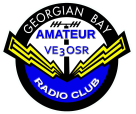2020-10-25, 17:26:47
But first, for those who may not be familiar with WSPR, here is a quick explanation. WSPR (pronounced "Whisper") stands for "Weak Signal Propagation Reporter". It was designed by Nobel Laureate Physicist Joe Taylor W1JT. It's purpose is to test propagation conditions by transmitting a low power signal that is encoded in such a way that it can be decoded by a remote station - even when the signal is far below the noise level and maybe even inaudible. It carries a fixed data payload containing only: CALLSIGN + MAIDENHEAD GRID LOCATOR + TRANSMITTED SIGNAL POWER (in dBm). For example VA3KOT EN94 37. Receiving stations upload signal reports to a website so that transmitting stations may see where their signal has been received. WSPR is a one way test signal mode not designed for QSOs.
So if WSPR is not a QSO mode how can we use it to hold a conversation over the air? That requires lateral thinking and some devious ingenuity. Anybody who has participated in traffic handling nets will be familiar with the ARRL's FSD-3 Relief Emergency - Routine Messages Recommended Procedures. FSD-3 contains a set of sixty nine packaged messages referred to only by their number identifier. For example ARRL 46 means "Greetings on your birthday and best wishes for many more to come".
WSPR transmissions are scheduled on even minutes and are 2 minutes in duration. Received signals are scheduled on odd minutes and are also two minutes in duration. Thus WSPR transmissions begin on minute numbers 2,4,6,8 ... 58, giving a total of 29 possible timeslots each hour. If the transmitting station and receiving station both share a set of 29 packaged messages then a "secret" message may be sent by selecting the appropriate timeslot for sending a message. If one or more of the packaged messages are a reply then we can see how a two-way conversation can be conducted. Alright, it's a constricted QSO, not a conversational free flow kind of rag chew but it is a QSO.
But wait. Let us suppose that 29 packaged messages are not enough. Well, there are other variables that can be used to encode our secret messages too. For example, we can vary the transmitted power. Transmitted power is expressed in dBm. That means power relative to 1 milliwatt. You can do the math if you wish using the formula dBm=10log(P2/P1) where P2 is transmitted power in watts and P1 is 1mW. A power of 37dBm is equal to 5 watts. The WSPR software restricts us to specific power levels but, all the same, we can use power level as another parameter to determine which packaged message is being sent.
If we select, say, five different power levels and assign an index number of 1 to 5 to each of those power levels, we can expand our list of packaged messages to 5 times 29 or 145 different messages. The list could be expanded much more by incorporating other variables such as the hour of the day in which the message is sent. That would give us 24 x 145 or 3480 packaged messages.
In order to avoid scrutiny by Industry Canada (or whatever fancy title the ministry has adopted these days) it would be necessary to make the list of packaged messages public.
One final note for the "prepper" community. In a "SHTF" situation in which society has broken down, government has stepped down and armed gangs are roaming the streets, won't you be glad you have a ham radio licence and you read this post!




